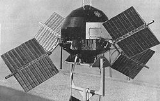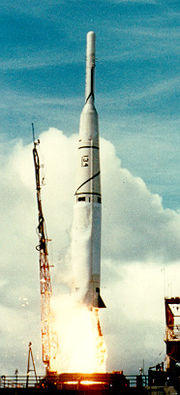
Explorer 6
Encyclopedia
Explorer 6 was a United States
satellite
launched on August 7, 1959. It was a small, spheroidal satellite designed to study trapped radiation of various energies, galactic cosmic ray
s, geomagnetism
, radio propagation
in the upper atmosphere
, and the flux
of micrometeorites
. It also tested a scanning device designed for photographing the Earth's
cloud cover, and transmitted the first pictures of Earth from orbit
.
 The satellite was launched into a highly elliptical orbit
The satellite was launched into a highly elliptical orbit
with an initial local time of apogee
of 2100 h. The satellite was spin-stabilized
at 2.8 rps, with the direction of the spin axis
having a right ascension
of 217 degrees
and a declination
of 23 degrees. Four solar cell
paddles mounted near its equator recharged the storage batteries while in orbit. Each experiment except the television scanner had two outputs, digital and analog. A UHF transmitter was used for the digital telemetry and the TV signal. Two VHF transmitters were used to transmit the analog signal. The VHF transmitters were operated continuously. The UHF transmitter was operated for only a few hours each day. Only three of the solar cell paddles fully erected, and this occurred during spin up rather than prior to spin up as planned. Consequently, initial operation of the payload power supply was 63% nominal, and this decreased with time. The decreased power caused a lower signal-to-noise ratio affecting most of the data, especially near apogee. One VHF transmitter failed on September 11, 1959, and the last contact with the payload was made on October 6, 1959, at which time the solar cell charging current had fallen below that required to maintain the satellite equipment.
In 1959 an anti-satellite missile test of the Bold Orion
rocket used Explorer 6 as a target. The missile successfully passed within 6.4 kilometres (4 mi) of the satellite.
The satellite's orbit decayed
on July 1, 1961.
A total of 827 hours of analog and 23 hours of digital data were obtained.
United States
The United States of America is a federal constitutional republic comprising fifty states and a federal district...
satellite
Satellite
In the context of spaceflight, a satellite is an object which has been placed into orbit by human endeavour. Such objects are sometimes called artificial satellites to distinguish them from natural satellites such as the Moon....
launched on August 7, 1959. It was a small, spheroidal satellite designed to study trapped radiation of various energies, galactic cosmic ray
Cosmic ray
Cosmic rays are energetic charged subatomic particles, originating from outer space. They may produce secondary particles that penetrate the Earth's atmosphere and surface. The term ray is historical as cosmic rays were thought to be electromagnetic radiation...
s, geomagnetism
Earth's magnetic field
Earth's magnetic field is the magnetic field that extends from the Earth's inner core to where it meets the solar wind, a stream of energetic particles emanating from the Sun...
, radio propagation
Radio propagation
Radio propagation is the behavior of radio waves when they are transmitted, or propagated from one point on the Earth to another, or into various parts of the atmosphere...
in the upper atmosphere
Earth's atmosphere
The atmosphere of Earth is a layer of gases surrounding the planet Earth that is retained by Earth's gravity. The atmosphere protects life on Earth by absorbing ultraviolet solar radiation, warming the surface through heat retention , and reducing temperature extremes between day and night...
, and the flux
Flux
In the various subfields of physics, there exist two common usages of the term flux, both with rigorous mathematical frameworks.* In the study of transport phenomena , flux is defined as flow per unit area, where flow is the movement of some quantity per time...
of micrometeorites
Micrometeoroid
A micrometeoroid is a tiny meteoroid; a small particle of rock in space, usually weighing less than a gram. A micrometeor or micrometeorite is such a particle that enters the Earth's atmosphere or falls to Earth.-Scientific interest:...
. It also tested a scanning device designed for photographing the Earth's
Earth
Earth is the third planet from the Sun, and the densest and fifth-largest of the eight planets in the Solar System. It is also the largest of the Solar System's four terrestrial planets...
cloud cover, and transmitted the first pictures of Earth from orbit
Orbit
In physics, an orbit is the gravitationally curved path of an object around a point in space, for example the orbit of a planet around the center of a star system, such as the Solar System...
.

Orbit
In physics, an orbit is the gravitationally curved path of an object around a point in space, for example the orbit of a planet around the center of a star system, such as the Solar System...
with an initial local time of apogee
Apsis
An apsis , plural apsides , is the point of greatest or least distance of a body from one of the foci of its elliptical orbit. In modern celestial mechanics this focus is also the center of attraction, which is usually the center of mass of the system...
of 2100 h. The satellite was spin-stabilized
Spin-stabilized satellite
A spin-stabilized satellite is a satellite which has the motion of one axis held fixed by spinning the satellite around that axis, using the gyroscopic effect.The attitude of a satellite or any rigid body is its orientation in space...
at 2.8 rps, with the direction of the spin axis
Rotation
A rotation is a circular movement of an object around a center of rotation. A three-dimensional object rotates always around an imaginary line called a rotation axis. If the axis is within the body, and passes through its center of mass the body is said to rotate upon itself, or spin. A rotation...
having a right ascension
Right ascension
Right ascension is the astronomical term for one of the two coordinates of a point on the celestial sphere when using the equatorial coordinate system. The other coordinate is the declination.-Explanation:...
of 217 degrees
Degree (angle)
A degree , usually denoted by ° , is a measurement of plane angle, representing 1⁄360 of a full rotation; one degree is equivalent to π/180 radians...
and a declination
Declination
In astronomy, declination is one of the two coordinates of the equatorial coordinate system, the other being either right ascension or hour angle. Declination in astronomy is comparable to geographic latitude, but projected onto the celestial sphere. Declination is measured in degrees north and...
of 23 degrees. Four solar cell
Solar cell
A solar cell is a solid state electrical device that converts the energy of light directly into electricity by the photovoltaic effect....
paddles mounted near its equator recharged the storage batteries while in orbit. Each experiment except the television scanner had two outputs, digital and analog. A UHF transmitter was used for the digital telemetry and the TV signal. Two VHF transmitters were used to transmit the analog signal. The VHF transmitters were operated continuously. The UHF transmitter was operated for only a few hours each day. Only three of the solar cell paddles fully erected, and this occurred during spin up rather than prior to spin up as planned. Consequently, initial operation of the payload power supply was 63% nominal, and this decreased with time. The decreased power caused a lower signal-to-noise ratio affecting most of the data, especially near apogee. One VHF transmitter failed on September 11, 1959, and the last contact with the payload was made on October 6, 1959, at which time the solar cell charging current had fallen below that required to maintain the satellite equipment.
In 1959 an anti-satellite missile test of the Bold Orion
Bold Orion
The Bold Orion missile, also known as Weapons System 199B , was a prototype air-launched ballistic missile developed by Martin Aircraft during the 1950s. Developed in both one- and two-stage designs, the missile was moderately successful in testing, and helped pave the way for development of the...
rocket used Explorer 6 as a target. The missile successfully passed within 6.4 kilometres (4 mi) of the satellite.
The satellite's orbit decayed
Orbital decay
Orbital decay is the process of prolonged reduction in the altitude of a satellite's orbit.This can be due to drag produced by an atmosphere due to frequent collisions between the satellite and surrounding air molecules. The drag experienced by the object is larger in the case of increased solar...
on July 1, 1961.
A total of 827 hours of analog and 23 hours of digital data were obtained.

